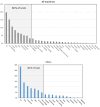Linear accelerator maintenance cost analysis
- PMID: 38134322
- PMCID: PMC10860406
- DOI: 10.1002/acm2.14246
Linear accelerator maintenance cost analysis
Abstract
Purpose: Medical linear accelerators are the most costly standard equipment used in radiation oncology, however the service costs for these machines are not well understood. With an increasing demand for linear accelerators due to a global increase in cancer incidence, it is important to understand the expected maintenance costs of a larger global installed base so that these costs can be incorporated into budgeting. The purpose of this investigation is to analyze the costs for medical linear accelerator service and maintenance at our institution, in order to estimate the service cost ratio.
Methods: We collected the costs of parts used for all service work done on 32 medical linear accelerators over a two year period. The data was segregated by center, machine, linear accelerator type, and failure area in the machine.
Results: We found the service cost ratio (excluding software support expenses) to be 3.13% [2.74%, 3.52%,]. We observed a variability of parts costs, and overall variability of the service cost ratio to be between 2.14% and 5.25%. This result is lower than other estimates for service costs for medical equipment in general and medical linear accelerators specifically. Two-thirds of the service costs were due to labor costs, which indicate the importance of a well-trained service technician workforce.
Conclusions: We estimated the service cost ratio for medical linear accelerators to be 3.13% [3.52%, 2.74%] of the initial capital cost. This result was lower than other estimates of the service cost ratio.
Keywords: linear accelerator; linear accelerator components; linear accelerator maintenance cost analysis; maintenance costs; service cost ratio.
© 2023 The Authors. Journal of Applied Clinical Medical Physics published by Wiley Periodicals LLC on behalf of American Association of Physicists in Medicine.
Conflict of interest statement
Marco Carlone is the founder and majority owner of Linax Technologies Ltd, 1869−3151 Lakeshore Rd, Kelowna, BC V1W 3S9.
Figures








References
-
- Laktash V. Medical equipment maintenance—Performing an audit to improve efficiency and savings. Health Facil Manage Magazine. 2015. March 4. Accessed May 24, 2023.Available at. https://www.hfmmagazine.com/articles/1493‐medical‐equipment‐maintenance
-
- Cohen T. The cost of biomedical equipment repair and maintenance: results of a survey. Med Instrum. 1982;16(5):269‐271. - PubMed
-
- Baumeister J. Hospital financial audit of medical equipment maintenance: a case study. J Clin Eng. 1987;12(3):197‐201. - PubMed
-
- van der Giessen PH. A comparison of maintenance costs of cobalt machines and linear accelerators. Radiother and Oncol. 1991;20(1):64‐65. - PubMed
-
- van der Giessen PH. Maintenance costs for cobalt machines and linear accelerators: new machines versus old. Radiother Oncol. 2002;62:349‐352. - PubMed
MeSH terms
LinkOut - more resources
Full Text Sources

